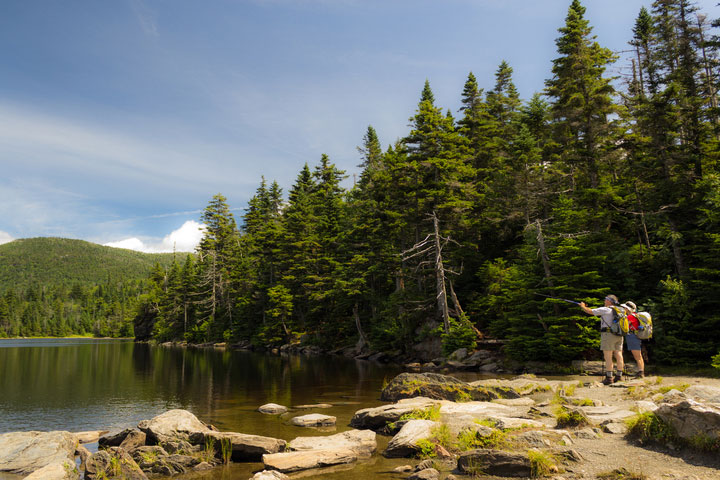One of the great things about a trip to the Green Mountains of Vermont is having the opportunity to observe and learn about wildlife. Here at Smugglers’ Notch, and in the surrounding area, some time spent in the field can yield numerous opportunities to view birds, woodland animals, and even aquatic species.
Before heading out on your wildlife viewing adventure, be aware that few species are active during the daytime and most species seek to avoid human presence. Plus, you want to be respectful of the animal and its habitat and enjoy their activities from a distance. Keeping these two points in mind, the following tips will help direct your efforts.
- When to go: Wildlife is most active during the first couple of hours of daylight and the last couple of hours before nightfall. Take a walk or a drive along the back roads near the resort during these time periods. Or, sign up for the resort’s guided Evening Wildlife Watch to enjoy wildlife spotting by canoe. Smugglers’ also offers an early morning Birds & Bloomers walk for bird and wildflower spotting with an expert guide.
- What to wear: Sturdy shoes for walking and clothing that offers protection from underbrush and insects to ensure comfort.
- What to bring: Binoculars and a camera if you’re so inclined. Although most animals are readily identifiable, a field guide for birds can be useful since you are likely to see many species. A small daypack can carry gear, a bottle of water, a snack and also hold clothing you might need as temperatures shift at the beginning and end of the day.
- What to do: Walk slowly and quietly on trails. Be patient, and stop frequently to listen. Often larger species make noise as they move through woods or brush. Open meadows can also be great spots to view wildlife. Sit quietly on the perimeter of a field to watch and listen.
- What about kids? Sure, you can wildlife watch with young kids! Pick a location that offers immediate interest to them. Choosing a spot alongside a stream gives children something to look at, and you might collect leaves to press later or a few interesting stones before settling down to wait for wildlife. A child can carry their own small pack and you could include any of the wonderful wildlife guides currently available for young children.
Successful wildlife watching requires two things: first, getting out into the natural world, and two, patience! Just imagine the excitement of spotting a critter. But even if you don’t, time spent in the natural world can be relaxing and rejuvenating, and offer connection with a friend or family member who accompanies you. In sum, any way you look at it, wildlife watching is a winning vacation activity.


I like that you provided some tips for watching wildlife such as considering what you need to wear. It is recommended that you wear sturdy shoes and comfortable clothing for your birdwatching adventure trip. You may also want to use some sunscreen protection as it can be very hot in the morning or early noon. If I were to go birdwatching with my family, I would make sure to keep this in mind. Thanks.
I really love your article about watching wildlife. Since I don’t know much about it, it’s good to know that wildlife is usually more active at dawn and dusk. I would love to go on a vacation to specifically watch wildlife and be able to just take pictures of them all day. That sounds like a dream vacation!
I’ve never heard that wildlife is most active during the first and last couple of hours of daylight! I also appreciate your tip to wear sturdy shoes for looking into wildlife observation. I’ve heard that using a wildlife travel guide is the best way to go when you want to observe wildlife.